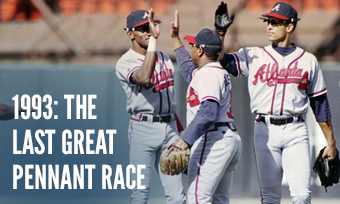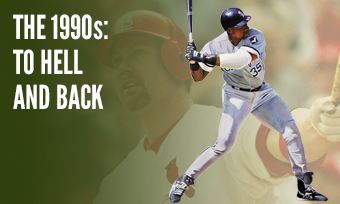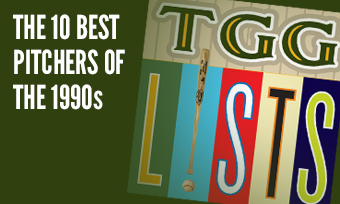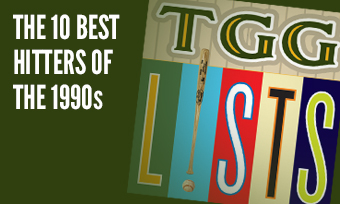The Yearly Reader
Leaders and Honors, 1993
Our list of baseball’s top 10 hitters and pitchers in both the American League and National League for the 1993 baseball season, as well as the awards and honors given to the game’s top achievers of the year.
The National League’s Top 10 Hitters, 1993
Bold type in brick red indicates league leader.
1. Barry Bonds, San Francisco
Key Numbers: .336 average, 129 runs, 181 hits, 38 doubles, 46 home runs, 123 RBIs, 126 walks, 43 intentional walks, 29 stolen bases, .458 on-base percentage, .677 slugging percentage.
Earning $43 million worth of respect he long sought, Bonds repaid the Giants in kind with a prodigious effort that more than confirmed his world-class status.
2. Ron Gant, Atlanta
Key Numbers: .274 average, 113 runs, 27 doubles, 36 home runs, 117 RBIs, 26 stolen bases.
The Braves’ slugger continued his roller-coaster career ride, following up a down year with an up-year; he’d be down again in 1994, missing the entire year (and losing his salary) after breaking his leg in a contract-violating ATV accident.
3. Lenny Dykstra, Philadelphia
Key Numbers: .305 average, 637 at-bats, 143 runs, 194 hits, 44 doubles, 6 triples, 19 home runs, 66 RBIs, 129 walks, 37 stolen bases.
You have to go back to Chuck Klein’s gaudy days at Baker Bowl to find anyone scoring as many runs for the Phillies as did Dykstra in 1993.
4. Fred McGriff, San Diego-Atlanta
Key Numbers: .291 average, 111 runs, 29 doubles, 37 home runs, 101 RBIs.
McGriff’s red-hot final 68 games with the Braves after being shoved out of penny-pinching San Diego helped him set a career high in home runs.
5. Andres Galarraga, Colorado
Key Numbers: 120 games, .370 average, 174 hits, 35 doubles, 22 home runs, 98 RBIs.
The former Cardinal had Colorado manager (and former St. Louis hitting coach) Don Baylor as much to thank as the thin, mile-high Denver air for bringing his career back from the dead.
6. Gregg Jefferies, St. Louis
Key Numbers: .342 average, 89 runs, 186 hits, 16 home runs, 83 RBIs, 46 stolen bases.
Stigmatized for his immaturity and horrendous defense, the one-time can’t-miss prospect Jefferies finally played to his potential at St. Louis.
7. Darren Daulton, Philadelphia
Key Numbers: .257 average, 90 runs, 35 doubles, 24 home runs, 105 RBIs, 117 walks.
A year after becoming the first Phillies catcher to knock in 100 runs, Daulton became the first Phillies catcher to do it twice.
8. John Kruk, Philadelphia
Key Numbers: .316 average, 100 runs, 33 doubles, 5 triples, 14 home runs, 85 RBIs, 111 walks.
Given up in 1989 by the Padres for fear he was fattening his way out of baseball, Kruk continued to gorge on opponents at Philadelphia.
9. Mike Piazza, Los Angeles
Key Numbers: .318 average, 81 runs, 174 hits, 35 home runs, 112 RBIs.
There was more than just Dodger Blue in common within the blood of Piazza and his manager, Tommy Lasorda, who was godfather to the rookie sensation’s brother.
10. Matt Williams, San Francisco
Key Numbers: .294 average, 105 runs, 170 hits, 33 doubles, 38 home runs, 110 RBIs.
After sliding to a .227 average and relatively scant 20 homers a year earlier, Williams was more than happy to ride the coattails of first-year Giant Barry Bonds.
The American League’s Top 10 Hitters, 1993
1. John Olerud, Toronto
Key Numbers: .363 average, 109 runs, 200 hits, 54 doubles, 2 triples, 24 home runs, 107 RBIs, 114 walks, 33 intentional walks, .473 on-base percentage.
Of the many All-Star names within the high-flying Toronto offense, no one flew higher than the previously unknown Olerud—though one wonders if he still wasn’t getting respect despite a Toronto-record .363 average and major league-best 26-game hit streak. He wasn’t even the top MVP vote-getter on his own team (Paul Molitor).
2. Frank Thomas, Chicago
Key Numbers: .317 average, 106 runs, 174 hits, 36 doubles, 41 home runs, 128 RBIs, 112 walks.
Unanimously beating Olerud (and Molitor) in the MVP race was Thomas, who made up for being denied in two previous, honor-worthy seasons; he mashed 40 homers for the first of five times in his career.
3. Ken Griffey Jr., Seattle
Key Numbers: .309 average, 113 runs, 180 hits, 38 doubles, 45 home runs, 109 RBIs, 96 walks, 25 intentional walks, 17 stolen bases.
After averaging 22 home runs through his first four seasons, Griffey catapulted into the 40-dinger range himself for the first of seven times in his Hall-of-Fame lifespan.
4. Juan Gonzalez, Texas
Key Numbers: .310 average, 105 runs, 33 doubles, 46 home runs, 118 RBIs. 13 hit-by-pitches, .632 slugging percentage.
“Juan Gone” Gonzalez led the AL in homers for the second straight year—but his .310 mark, after a couple years in the .260s, is what really scared pitchers.
5. Paul Molitor, Toronto
Key Numbers: .332 average, 121 runs, 211 hits, 37 doubles, 5 triples, 22 home runs, 111 RBIs, 22 stolen bases.
For those who think Molitor, in his first year at Toronto, was firmly content in the DH role, he actually hit a sizzling .452 in the 23 games that he started at first base.
6. Rafael Palmeiro, Texas
Key Numbers: .295 average, 124 runs, 176 hits, 40 doubles, 37 home runs, 105 RBIs, 22 intentional walks, 22 stolen bases.
Another of an unusual number of American Leaguers whose home run production shot up in 1993, Palmeiro’s 37 blasts were 11 higher than his previous career high. He’d surpassed that number nine more times.
7. Roberto Alomar, Toronto
Key Numbers: .326 average, 109 runs, 192 hits, 35 doubles, 6 triples, 17 home runs, 93 RBIs, 80 walks, 55 stolen bases.
Still the Blue Jays’ most complete offensive threat, Alomar was one of four players on the team with at least 109 runs. The last team to claim that stat? The 1949 Red Sox.
8. Albert Belle, Cleveland
Key Numbers: .290 average, 93 runs, 172 hits, 36 doubles, 38 home runs, 129 RBIs, 23 stolen bases, 14 sacrifice flies.
Albert Belle—that’s no longer Joey to you, creep—continued his growth as one of the most fearsome and surly of numerous young talents in Cleveland.
9. Rickey Henderson, Oakland-Toronto
Key Numbers: 134 games, .289 average, 114 runs, 21 home runs, 59 RBIs, 120 walks, 53 stolen bases.
Playing close to his 1990 MVP level with the A’s, Rickey was sent to Toronto for a short-lived, two-month tenure—and hit just .212.
10. Carlos Baerga, Cleveland
Key Numbers: .321 average, 105 runs, 200 hits, 28 doubles, 6 triples, 21 home runs, 114 RBIs, 15 stolen bases.
Reaching his peak in a 14-year career that strangely petered out midway through, Baerga became the third Cleveland player (after Joe Jackson and Dale Mitchell) to collect 200-plus hits in back-to-back seasons.
The National League’s Top 10 Pitchers, 1993
1. Greg Maddux, Atlanta
Key Numbers: 2.36 ERA, 20 wins, 10 losses, 36 starts, 8 complete games, 267 innings, 52 walks, 27 stolen bases allowed, 26 grounded into double plays.
Maddux likely converted any last holdouts who doubted he was head and shoulders above all other NL pitchers.
2. Bill Swift, San Francisco
Key Numbers: 2.82 ERA, 21 wins, 8 losses, .724 win percentage, 34 starts, 232.2 innings, 26 grounded into double plays.
The perennially fragile Swift was able to tape it all together for one terrific year, pairing up with John Burkett to become the first pair of 20-game winning Giants since 1966.
3. Jose Rijo, Cincinnati
Key Numbers: 2.48 ERA, 14 wins, 9 losses, 36 starts, 257.1 innings, 227 strikeouts, 22 stolen bases allowed.
After years struggling to hop over the 200-inning mark, Rijo went full workhorse with, easily, career highs in starts and innings thrown; it was his sixth straight season producing a sub-3.00 ERA.
4. John Burkett, San Francisco
Key Numbers: 3.65 ERA, 22 wins, 7 losses, .759 win percentage, 34 starts, 231.2 innings, 40 walks, 14 caught stealing/picked off, 21 grounded into double plays.
Burkett, who once bowled a perfect 300, had a field year bowling for Giants wins on the mound.
5. Steve Avery, Atlanta
Key Numbers: 2.94 ERA, 18 wins, 6 losses, .750 win percentage, 35 starts, 223.1 innings, 43 walks, 32 stolen bases allowed, 26 grounded into double plays.
The Braves were briefly blessed with the “Big Four” as Avery looked every bit as good as Greg Maddux, Tom Glavine and John Smoltz; but while the other three would cruise long-term toward Cooperstown, the 23-year-old southpaw would succumb to injuries and underperformance after 1993.
6. John Wetteland, Montreal
Key Numbers: 1.37 ERA, 9 wins, 3 losses, 43 saves, 6 blown saves, 70 appearances, 85.1 innings, 13 stolen bases allowed.
The second-year Expos closer set a career mark with 43 saves—a number he would match twice more in his remaining seven seasons.
7. Mark Portugal, Houston
Key Numbers: 2.77 ERA, 18 wins, 4 losses, .818 win percentage, 33 starts, 208 innings.
Putting it all together after eight years of trying, the 30-year-old right-hander was particularly so tough on the Giants (career 11-3 mark, 2.55 ERA) that they signed him the next year—if for anything else, so they wouldn’t have to face him anymore.
8. Rod Beck, San Francisco
Key Numbers: 2.16 ERA, 3 wins, 1 loss, 48 saves, 4 blown saves, 76 appearances, 79.1 innings, 13 walks.
The burly, scruffy-haired “Shooter” began a stretch of six seasons in which he’d average nearly 40 saves per year.
9. Jeff Fassero, Montreal
Key Numbers: 2.29 ERA, 12 wins, 5 losses, .706 win percentage, 1 save, 2 blown saves, 56 appearances, 15 starts, 149.2 innings.
One of many rising young starts on a talented Expos team, Fassero was equally good as a first-half reliever (2.28 ERA) and second-half starter (2.29).
10. Tom Glavine, Atlanta
Key Numbers: 3.20 ERA, 22 wins, 6 losses, .786 win percentage, 36 starts, 239.1 innings, 25 grounded into double plays.
The taciturn southpaw became the first NL pitcher since Warren Spahn (1957-61) to pace the circuit in wins three years in a row.
The American League’s Top 10 Pitchers, 1993
1. Kevin Appier, Kansas City
Key Numbers: 2.41 ERA, 18 wins, 11 losses, 32 starts, 11 complete games, 5 shutouts, 246.2 innings, 24 stolen bases, 28 grounded into double plays.
Fully blossomed into the Royals’ ace, Appier secured his lone ERA crown with the help of a franchise-record string of 33.2 scoreless innings in September.
2. Jimmy Key, New York
Key Numbers: 3.00 ERA, 18 wins, 6 losses, .750 win percentage, 34 starts, 236.2 innings, 43 walks, 25 grounded into double plays.
Switching allegiances from maple leafs to pinstripes, the veteran lefty collected a personal-best total of wins and became, for now, the top mainstay of the Yankees’ rotation.
3. Jack McDowell, Chicago
Key Numbers: 3.37 ERA, 22 wins, 10 losses, 4 shutouts, .688 win percentage, 34 starts, 256.2 innings.
The lanky right-hander, winning at least 20 for the second straight year, wasn’t the hardest guy to get a hit off of—but he always found a way to outlast you.
4. Mark Langston, California
Key Numbers: 3.20 ERA, 16 wins, 11 losses, 35 starts, 256.1 innings, 10 wild pitches, 23 grounded into double plays.
The 33-year-old lefty kept a weak Angels team competitive, before fortunes would turn for both; his ERA over the next six seasons would be an iffy 4.99.
5. Alex Fernandez, Chicago
Key Numbers: 3.13 ERA, 18 wins, 9 losses, 34 starts, 247.1 innings, 24 grounded into double plays.
In his fourth season, Fernandez suddenly rose to be a top complement to Jack McDowell, learning to shrug off home runs after it had previously bothered him; 18 of the 27 he gave up in 1993 were solo.
6. Randy Johnson, Seattle
Key Numbers: 3.24 ERA, 19 wins, 8 losses, .704 win percentage, 1 save, 34 starts, 255.1 innings, 308 strikeouts, 16 hit-by-pitches, 28 stolen bases allowed.
Johnson once scared opponents with his blazing wildness; now his lack of it scared them even more. While he struck out over 300 batters, no other AL pitcher collected more than 200.
7. Jeff Montgomery, Kansas City
Key Numbers: 2.27 ERA, 7 wins, 5 losses, 45 saves, 6 blown saves, 69 appearances, 87.1 innings.
Outside of the heartland—and very possibly within it—the Royals’ Jeff Montgomery was one of the game’s most effective but unheralded closers.
8. Wilson Alvarez, Chicago
Key Numbers: 2.95 ERA, 15 wins, 8 losses, 31 starts, 207.2 innings, 122 walks, 21 stolen bases allowed, 17 caught stealing/picked off, 23 grounded into double plays.
The Venezuelan-born southpaw was yet another reason Rangers fans hated the Sammy Sosa-for-Harold Baines trade back in 1989; Alvarez was part of the deal that landed him in Chicago.
9. Duane Ward, Toronto
Key Numbers: 2.13 ERA, 2 wins, 3 losses, 45 saves, 6 blown saves, 71 appearances, 71.2 innings.
With Tom Henke gone to the White Sox, Ward took full advantage and thrived as the Jays’ full-time closer—but biceps tendinitis would force his 1993 campaign to serve as his career coda.
10. Chris Bosio, Seattle
Key Numbers: 3.45 ERA, 9 wins, 9 losses, 1 save, 1 blown save, 29 appearances, 24 starts, 164.1 innings.
A mostly-up but sometimes-down year for Bosio, tugged in by the Mariners after seven years in Milwaukee; he threw a no-hitter against Boston in his fourth start, was quickly thereafter placed on the shelf for a month, and after a brief midseason swoon finished strong.









